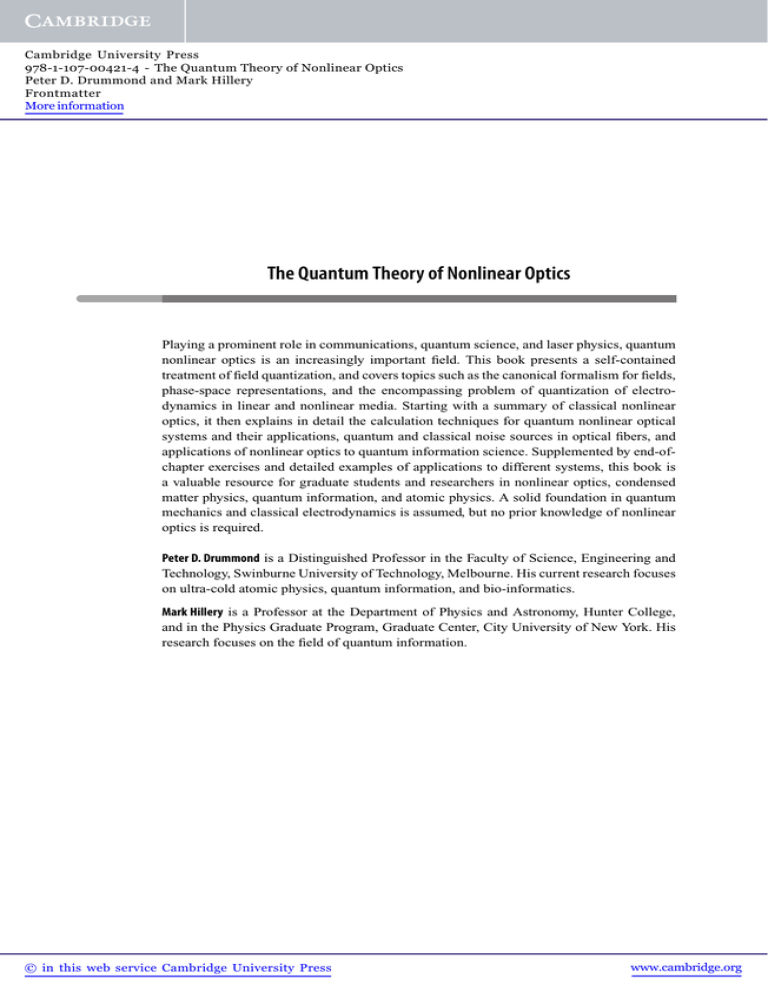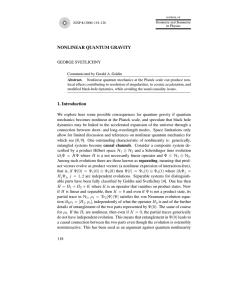The Quantum Theory of Nonlinear Optics - Assets
advertisement

Cambridge University Press 978-1-107-00421-4 - The Quantum Theory of Nonlinear Optics Peter D. Drummond and Mark Hillery Frontmatter More information The Quantum Theory of Nonlinear Optics Playing a prominent role in communications, quantum science, and laser physics, quantum nonlinear optics is an increasingly important field. This book presents a self-contained treatment of field quantization, and covers topics such as the canonical formalism for fields, phase-space representations, and the encompassing problem of quantization of electrodynamics in linear and nonlinear media. Starting with a summary of classical nonlinear optics, it then explains in detail the calculation techniques for quantum nonlinear optical systems and their applications, quantum and classical noise sources in optical fibers, and applications of nonlinear optics to quantum information science. Supplemented by end-ofchapter exercises and detailed examples of applications to different systems, this book is a valuable resource for graduate students and researchers in nonlinear optics, condensed matter physics, quantum information, and atomic physics. A solid foundation in quantum mechanics and classical electrodynamics is assumed, but no prior knowledge of nonlinear optics is required. Peter D. Drummond is a Distinguished Professor in the Faculty of Science, Engineering and Technology, Swinburne University of Technology, Melbourne. His current research focuses on ultra-cold atomic physics, quantum information, and bio-informatics. Mark Hillery is a Professor at the Department of Physics and Astronomy, Hunter College, and in the Physics Graduate Program, Graduate Center, City University of New York. His research focuses on the field of quantum information. © in this web service Cambridge University Press www.cambridge.org Cambridge University Press 978-1-107-00421-4 - The Quantum Theory of Nonlinear Optics Peter D. Drummond and Mark Hillery Frontmatter More information This book forms part of an informal series of books, all of which originated as review articles published in Acta Physica Slovaca. The journal can be accessed for free at www.physics.sk/aps. Vladimir Buzek, editor of the journal “This book is a valuable contribution to the scientific literature by addressing issues that fall at the boundary between quantum optics and nonlinear optics. It is exactly at this boundary where one might expect exciting advances to develop in the coming years. The authors have done a good job in selecting the topics for inclusion in their very fine text.” Robert W. Boyd Canada Excellence Research Chair in Quantum Nonlinear Optics, University of Ottawa Professor of Optics and of Physics, University of Rochester “Two of the pioneers of quantum optics have produced a clear introduction to the quantum theory of nonlinear optical processes with applications ranging from laser physics to quantum information. The powerful method of P representations to treat quantum stochastic processes is introduced with exemplary clarity and many examples. This is an essential introduction for graduate students, who will appreciate the carefully chosen problem sets, and a valuable reference for experienced researchers in the field.” Gerard J. Milburn Centre Director, Centre for Engineered Quantum Systems, University of Queensland © in this web service Cambridge University Press www.cambridge.org Cambridge University Press 978-1-107-00421-4 - The Quantum Theory of Nonlinear Optics Peter D. Drummond and Mark Hillery Frontmatter More information The Quantum Theory of Nonlinear Optics PETER D. DRUMMOND Swinburne University of Technology, Melbourne MARK HILLERY Hunter College, City University of New York © in this web service Cambridge University Press www.cambridge.org Cambridge University Press 978-1-107-00421-4 - The Quantum Theory of Nonlinear Optics Peter D. Drummond and Mark Hillery Frontmatter More information iv University Printing House, Cambridge CB2 8BS, United Kingdom Published in the United States of America by Cambridge University Press, New York Cambridge University Press is a part of the University of Cambridge. It furthers the University’s mission by disseminating knowledge in the pursuit of education, learning and research at the highest international levels of excellence. www.cambridge.org Information on this title: www.cambridge.org/9781107004214 C P. D. Drummond & M. Hillery 2014 This publication is in copyright. Subject to statutory exception and to the provisions of relevant collective licensing agreements, no reproduction of any part may take place without the written permission of Cambridge University Press. Cover artwork by Igor Minarik. First published 2014 Printed in the United Kingdom by Clays, St Ives plc A catalogue record for this publication is available from the British Library Library of Congress Cataloguing in Publication data Drummond, P. D. (Peter D.), 1950– The quantum theory of nonlinear optics / Peter D. Drummond, Swinburne University of Technology, Melbourne, Mark Hillery, Hunter College, City University of New York. pages cm Includes bibliographical references and index. ISBN 978-1-107-00421-4 (hardback) 1. Nonlinear optics. 2. Quantum optics. 3. Quantum theory. I. Hillery, Mark Stephen. II. Title. QC446.2.D78 2014 535 .2 – dc23 2013030430 ISBN 978-1-107-00421-4 Hardback Cambridge University Press has no responsibility for the persistence or accuracy of URLs for external or third-party internet websites referred to in this publication, and does not guarantee that any content on such websites is, or will remain, accurate or appropriate. © in this web service Cambridge University Press www.cambridge.org Cambridge University Press 978-1-107-00421-4 - The Quantum Theory of Nonlinear Optics Peter D. Drummond and Mark Hillery Frontmatter More information Contents Preface page ix Introduction 1 Classical nonlinear optics 1.1 1.2 1.3 1.4 1.5 1.6 1.7 1.8 1.9 Linear polarizability Nonlinear polarizability Frequency dependence and dispersion Power and energy Order-of-magnitude estimates The two-level atom Local-field corrections Propagation in a nonlinear medium Raman processes Additional reading Problems 2 Field quantization 2.1 2.2 2.3 2.4 2.5 2.6 2.7 2.8 2.9 2.10 Quantum theory Fock space for bosons Many-body operators Fock space for fermions Canonical quantization One-dimensional string Scattering matrix Quantized free electromagnetic field Constrained quantization Exponential complexity Additional reading Problems 3 Quantized fields in dielectric media 3.1 3.2 3.3 3.4 Dispersionless linear quantization Scattering in linear media Quantizing a nonlinear dielectric Homogeneous nonlinear dielectric © in this web service Cambridge University Press 1 4 4 7 10 12 16 17 24 29 32 34 35 37 37 41 44 48 50 53 57 66 73 78 81 81 83 83 89 92 94 www.cambridge.org Cambridge University Press 978-1-107-00421-4 - The Quantum Theory of Nonlinear Optics Peter D. Drummond and Mark Hillery Frontmatter More information Contents vi 3.5 Inhomogeneous nonlinear dielectric 3.6 Dispersion 3.7 One-dimensional waveguide Additional reading Problems 4 Microscopic description of media 4.1 4.2 4.3 4.4 4.5 4.6 4.7 4.8 The Coulomb gauge The multipolar gauge Hamiltonian for a polarizable medium Dipole-coupling approximation Linear medium Quantization of the linear model Two-level atomic medium Polaritonic limit Additional reading Problems 5 Coherence and quantum dynamics in simple systems 5.1 5.2 5.3 5.4 5.5 5.6 5.7 5.8 5.9 5.10 Photon counting and quantum coherence Quadratures and beam-splitters Coherent states and P-representations Nonclassical states Two-mode states Mode entanglement Parametric interactions Anharmonic oscillator and Schrödinger’s cat Jaynes–Cummings dynamics Parametric approximation Additional reading Problems 6 Decoherence and reservoirs 6.1 6.2 6.3 6.4 6.5 6.6 6.7 6.8 6.9 6.10 Reservoir Hamiltonians Absorption Gain Phase decoherence Input–output relations Photon flux and density Two-time correlation functions Master equations Gain and damping rates Driven linear cavity example © in this web service Cambridge University Press 96 103 108 113 113 116 116 119 123 127 129 134 136 139 142 142 144 144 149 151 154 157 160 163 170 175 177 181 182 184 184 187 191 195 198 201 206 207 211 212 www.cambridge.org Cambridge University Press 978-1-107-00421-4 - The Quantum Theory of Nonlinear Optics Peter D. Drummond and Mark Hillery Frontmatter More information Contents vii Additional reading Problems 7 Phase-space distributions 7.1 7.2 7.3 7.4 7.5 7.6 7.7 7.8 7.9 7.10 Diffusion processes Fokker–Planck equations Stochastic differential equations Phase-space representations Wigner and Q-representations Nonclassical representations Operator identities and quantum dynamics Quasi-probability Fokker–Planck equation Linearized fluctuation theory Functional phase-space representations Additional reading Problems 8 Single-mode devices 8.1 8.2 8.3 8.4 8.5 8.6 8.7 8.8 Linear cavity Phase-space representation methods Driven nonlinear absorber Squeezing and photon anti-bunching High-Q laser Laser linewidth Laser quantum state: number or coherent? Open nonlinear interferometer Additional reading Problems 9 Degenerate parametric oscillator 9.1 9.2 9.3 9.4 9.5 Hamiltonian and stochastic equations Classical results Fokker–Planck and stochastic equations Adiabatic approximation Multi-mode treatment of parametric down-conversion in a cavity Additional reading Problems 10 Quantum field dynamics 10.1 10.2 10.3 10.4 10.5 Kerr medium Quantum solitons Time-dependent Hartree approximation Quantum solitons in phase space Parametric down-conversion © in this web service Cambridge University Press 214 215 217 217 220 223 228 231 235 241 245 250 251 253 254 256 256 257 262 264 268 272 274 276 280 280 283 283 285 287 290 291 296 296 298 299 301 304 307 308 www.cambridge.org Cambridge University Press 978-1-107-00421-4 - The Quantum Theory of Nonlinear Optics Peter D. Drummond and Mark Hillery Frontmatter More information Contents viii 10.6 Maxwell–Bloch equations Additional reading Problems 312 317 318 11 Quantum propagation in fibers and waveguides 319 319 321 323 326 328 330 333 336 337 341 344 345 11.1 11.2 11.3 11.4 11.5 11.6 11.7 11.8 11.9 11.10 Order-of-magnitude estimates Waveguide modes Dispersive energy Nonlinear Hamiltonian Fiber optic Hamiltonian Raman Hamiltonian Gain and absorption Combined Heisenberg equations Phase-space methods Polarization squeezing Additional reading Problems 12 Quantum information 12.1 12.2 12.3 12.4 12.5 12.6 The Einstein–Podolsky–Rosen paradox Bell inequality Schrödinger cat paradoxes Probabilistic simulations of Bell violations Quantum cloning Teleportation Additional reading Problems List of symbols Index © in this web service Cambridge University Press 346 347 350 355 358 360 363 366 367 369 371 www.cambridge.org Cambridge University Press 978-1-107-00421-4 - The Quantum Theory of Nonlinear Optics Peter D. Drummond and Mark Hillery Frontmatter More information Preface This book grew out of our work in the field of the quantum theory of nonlinear optics. Some of this work we have done together and some following our own paths. One major emphasis of this work has been the quantization of electrodynamics in the presence of dielectric media. This is a subject that is often given short shrift in many treatments, and we felt that a book in which it receives a more extensive discussion was warranted. M.H. would like to thank his thesis advisor, Eyvind Wichmann, for an excellent education in quantum mechanics and quantum field theory, and M. Suhail Zubairy for introducing him to the field of nonlinear optics with quantized fields. Others who played a major role are Leonard Mlodinow, with whom the initial work on quantization in nonlinear media was done, and Janos Bergou and Vladimir Buzek, long-time collaborators with whom it has been a pleasure to work. He also thanks Carol Hutchins for many things. P.D.D. wishes to acknowledge his parents and family for their invaluable support. The many colleagues who helped form his approach include Crispin Gardiner and the late Dan Walls, who pioneered quantum optics in New Zealand. Subhash Chaturvedi, Howard Carmichael, Steve Carter, Paul Kinsler, Joel Corney, Piotr Deuar and Kaled Dechoum have contributed greatly to this field. He also thanks Margaret Reid, who has played a leading role in some of the developments outlined in the quantum information section, and Qiongyi He, who provided illustrations. © in this web service Cambridge University Press www.cambridge.org





